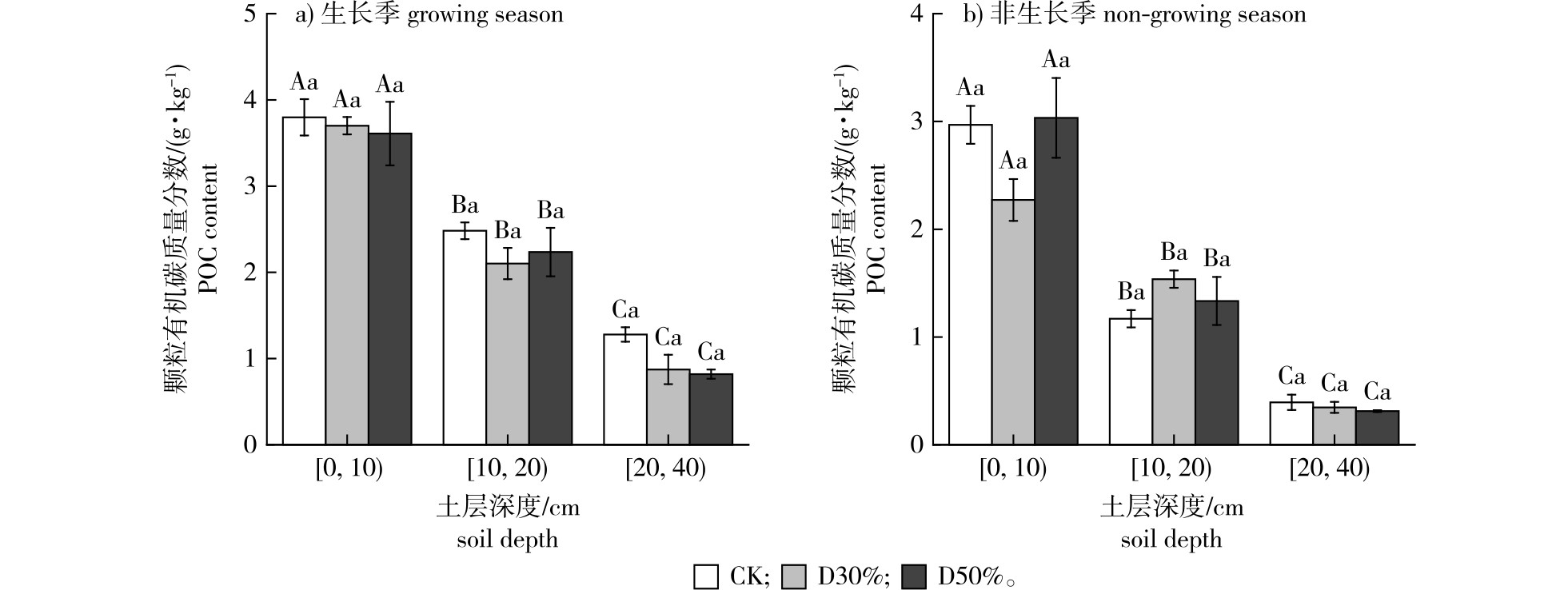【目的】全球干旱事件日益频繁,显著影响森林生态系统的结构和功能。研究旨在评估干旱对杨树人工林地不同深度土层颗粒有机碳(POC)和矿物结合态有机碳(MAOC)的影响,为预测未来森林土壤有机碳(SOC)及其稳定性对干旱的响应提供依据。【方法】以江苏东台林场10年生杨树人工林为研究对象,于2018年8月在此设置了隔离穿透雨的3种干旱处理:即空白对照处理(CK)、隔离30%穿透雨的中度干旱(D30%)、隔离50%穿透雨的重度干旱(D50%)。各处理设置3个重复样地,共9块样地。经过连续4年的野外控制实验,于2022年7月、11月,2023年2月、4月,采集各干旱处理样地内的土壤样品,测定生长季(2022年7月)和非生长季(2023年2月)的土壤POC和MAOC含量,以及上述4个时段的总土壤有机碳、可溶性有机碳、微生物生物量碳、易氧化有机碳等土壤理化性质。基于方差分析、相关性分析以及冗余分析,量化干旱胁迫下土壤POC和MAOC含量的变化特征,并分析驱动其含量变化的关键因子。【结果】干旱对土壤POC含量没有显著影响,对土壤MAOC含量的影响受季节、干旱程度和土层深度的制约。具体表现为:在生长季,中度干旱(D30%)显着增加了[0,10)cm表层土的MAOC含量,两种干旱处理(D30%和D50%)均显著降低了[10,20)cm中层土和[20,40)cm下层土的MAOC含量;在非生长季,两种干旱处理(D30%和D50%)均显著降低了表层土的MAOC含量,对中下层土的影响则不显著。从垂直分布上看,总体上土壤POC和MAOC含量随土层加深而显著降低。相关性分析结果表明,POC和MAOC含量与大多数土壤理化性质呈极显著正相关关系(P<0.01),与容重(BD)和碳氮比(C/N)呈极显著负相关关系(P<0.01)。冗余分析结果表明,干旱处理下,土壤微生物生物量碳(MBC)是驱动土壤POC和MAOC含量动态变化的关键因子。【结论】干旱对杨树人工林土壤POC含量无显著影响,但显著改变了土壤MAOC含量,其影响效应受季节、干旱程度和土层深度等因素的制约。本研究表明, 在预测未来森林土壤碳库稳定性对干旱的响应时应充分考虑季节、干旱程度和土层深度等因素。
【Objective】The increasing frequency of global drought events has significantly affected the structure and function of forest ecosystems. This study aims to estimate the effects of drought on contents of particulate organic carbon (POC) and mineral-associated organic carbon (MAOC) at different soil depths in poplar plantation, providing a theoretical basis for predicting the responses of forest soil organic carbon (SOC) and its stability to drought in the future.【Method】We took a 10-year-old poplar plantation in Dongtai Forest Farm, Jiangsu Province as the research object. In August 2018, three drought treatments for reducing throughfall were set up: i.e., a control treatment (CK), a moderate drought with reduced 30% throughfall (D30%), and a severe drought with reduced 50% throughfall (D50%). Three replicate sample plots were set up for each treatment with a total of nine sample plots. After four consecutive years of field controll experiments, soil samples were collected in July and November 2022, and February and April 2023 in each drought-treated sample plot to determine soil POC and MAOC contents in the growing (July 2022) and non-growing (February 2023) seasons, as well as soil physicochemical properties such as SOC, dissolved organic carbon, microbial biomass carbon, and readily oxidizable organic carbon in these four periods. Based on ANOVA, correlation analysis, and redundancy analysis, we quantified the characteristics of changes in soil POC and MAOC under drought stress and analyzed the key factors driving the variation in their contents.【Result】Drought had no significant effect on soil POC content, while its impact on soil MAOC content was constrained by season, drought degree and soil depth. Specifically, during the growing season, moderate drought (D30%) significantly increased the MAOC content in the surface soil [0,10)cm, while both drought treatments (D30% and D50%) significantly decreased the MAOC content in the middle soil layer ([10,20)cm) and lower soil layers ([20,40) cm). During the non-growing season, both drought treatments (D30% and D50%) significantly reduced the MAOC content in the surface soil, but had no significant effect on the middle and lower soil layers. Vertically, the soil POC and MAOC content decreased significantly with soil depth. The correlation results showed that POC and MAOC content were significantly and positively correlated with most soil physical and chemical properties, while were significantly and negatively correlated with bulk density and carbon to nitrogen ratio(C/N). Redundancy analysis indicated that soil microbial biomass carbon was the key factor driving the dynamic changes of soil POC and MAOC content under drought.【Conclusion】Drought had no significant effect on soil POC content in the poplar plantation; however, it significantly altered soil MAOC contents, and the effect was constrained by factors such as season, drought degree, and soil depth. This study suggests that when predicting the response of forest soil carbon pool stability to drought in the future, factors such as season, drought degree and soil depth should be fully considered.
 PDF(2378 KB)
PDF(2378 KB)


 PDF(2378 KB)
PDF(2378 KB)
 PDF(2378 KB)
PDF(2378 KB)
